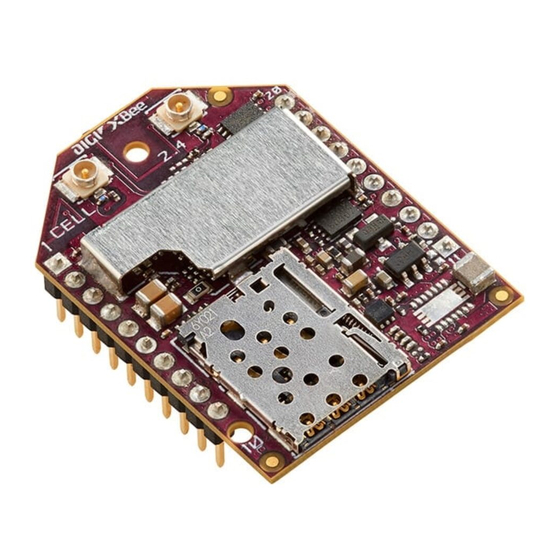
Digi XBee3 XB3M1 Manuals
Manuals and User Guides for Digi XBee3 XB3M1. We have 1 Digi XBee3 XB3M1 manual available for free PDF download: User Manual
Digi XBee3 XB3M1 User Manual (252 pages)
Cellular LTE-M/NB-IoT Smart Modem
Table of Contents
-
-
-
Debugging63
-
-
-
-
-
Examples80
-
Hardware
105-
Pin Signals106
-
Rssi Pwm108
-
SIM Card108
-
-
Clean Shutdown115
-
Sleep Feature116
-
Airplane Mode116
-
Modes
120-
Command Mode122
-
Micropython Mode124
-
USB Direct Mode125
-
Sleep Modes
127 -
-
Airplane Mode131
-
PSM Behavior131
-
Deep Sleep Mode131
-
-
-
Serial Interface134
-
Serial Data134
-
UART Data Flow134
-
Serial Buffers135
-
CTS Flow Control135
-
RTS Flow Control135
-
I2C136
-
-
SPI Operation
137-
Data Format141
-
File System
142-
-
Paths143
-
Secure Files143
-
XCTU Interface144
-
Encrypt Files144
-
-
Socket Behavior
145-
Socket Timeouts146
-
-
TLS at Commands152
-
API Mode and TLS153
-
Key Formats153
-
Cipher Suites154
-
-
Atcommands
158-
Special Commands158
-
FR (Force Reset)158
-
WR (Write)158
-
-
S# (ICCID)160
-
IM (Imei)160
-
MN (Operator)160
-
Network Commands165
-
-
N1 (DNS Address)170
-
N2 (DNS Address)170
-
C0 (Source Port)171
-
-
BD (Baud Rate)172
-
NB (Parity)172
-
SB (Stop Bits)173
-
AP (API Enable)174
-
-
-
D0 (Dio0/Ad0)175
-
D1 (Dio1/Ad1)175
-
D2 (Dio2/Ad2)176
-
D3 (Dio3/Ad3)176
-
D4 (Dio4)176
-
D6 (Dio6/Rts)177
-
D7 (Dio7/Cts)177
-
P3 (Dio13/Dout)180
-
P4 (Dio14/Din)181
-
-
-
TP (Temperature)183
-
-
Sleep Commands185
-
-
R (Modem Reset)196
-
-
Error Responses197
-
Atfs Pwd197
-
Atfs Info198
-
-
BLE Commands200
-
-
System Commands205
-
-
API Frames
212 -
-
FW Update - 0X2B235
-
Important Notes236
-
Error Recovery237
-
Troubleshooting
238-
Brownout Issue243
-
Socket Leaks244
Advertisement
Advertisement
